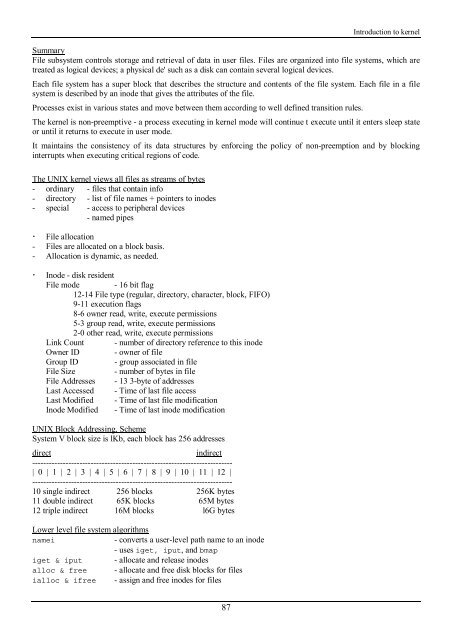Create successful ePaper yourself
Turn your PDF publications into a flip-book with our unique Google optimized e-Paper software.
Introduction to kernel<br />
Summary<br />
File subsystem controls storage and retrieval of data in user files. Files are organized into file systems, which are<br />
treated as logical devices; a physical de' such as a disk can contain several logical devices.<br />
Each file system has a super block that describes <strong>the</strong> structure and contents of <strong>the</strong> file system. Each file in a file<br />
system is described by an inode that gives <strong>the</strong> attributes of <strong>the</strong> file.<br />
Processes exist in various states and move between <strong>the</strong>m according to well defined transition rules.<br />
The kernel is non-preemptive - a process executing in kernel mode will continue t execute until it enters sleep state<br />
or until it returns to execute in user mode.<br />
It maintains <strong>the</strong> consistency of its data structures by enforcing <strong>the</strong> policy of non-preemption and by blocking<br />
interrupts when executing critical regions of code.<br />
The UNIX kernel views all files as streams of bytes<br />
- ordinary - files that contain info<br />
- directory - list of file names + pointers to inodes<br />
- special - access to peripheral devices<br />
- named pipes<br />
! File allocation<br />
- Files are allocated on a block basis.<br />
- Allocation is dynamic, as needed.<br />
! Inode - disk resident<br />
File mode - 16 bit flag<br />
12-14 File type (regular, directory, character, block, FIFO)<br />
9-11 execution flags<br />
8-6 owner read, write, execute permissions<br />
5-3 group read, write, execute permissions<br />
2-0 o<strong>the</strong>r read, write, execute permissions<br />
Link Count - number of directory reference to this inode<br />
Owner ID - owner of file<br />
Group ID - group associated in file<br />
File Size - number of bytes in file<br />
File Addresses - 13 3-byte of addresses<br />
Last Accessed - Time of last file access<br />
Last Modified - Time of last file modification<br />
Inode Modified - Time of last inode modification<br />
UNIX Block Addressing, Scheme<br />
System V block size is lKb, each block has 256 addresses<br />
direct<br />
indirect<br />
------------------------------------------------------------------------<br />
| 0 | 1 | 2 | 3 | 4 | 5 | 6 | 7 | 8 | 9 | 10 | 11 | 12 |<br />
------------------------------------------------------------------------<br />
10 single indirect 256 blocks 256K bytes<br />
11 double indirect 65K blocks 65M bytes<br />
12 triple indirect 16M blocks l6G bytes<br />
Lower level file system algorithms<br />
namei<br />
- converts a user-level path name to an inode<br />
- uses iget, iput, and bmap<br />
iget & iput - allocate and release inodes<br />
alloc & free - allocate and free disk blocks for files<br />
ialloc & ifree - assign and free inodes for files<br />
87
















